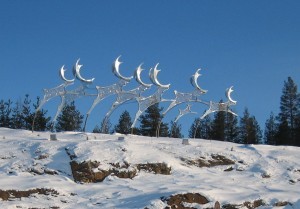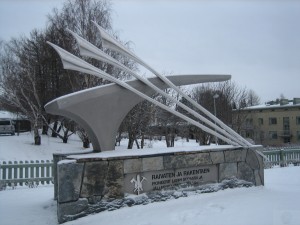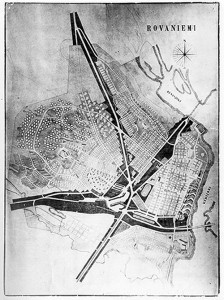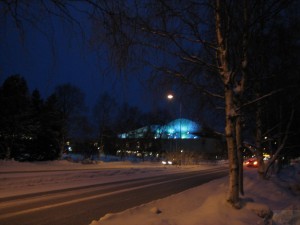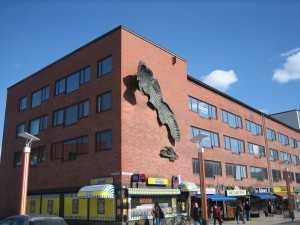The first you see as you arrive to the airport of Rovaniemi is “The Reindeer of Christmas Land” sculpture. The artist Urpo Kärri was born in Lappeenranta in the south of Finland, but moved to Kemijärvi in Lapland around 1960. At the beginning he worked with wood in his art and he has also created the altarpiece “Miserere” in the Ounasjoki chapel. He is also known as an ice- and snow sculptor, who has taken part in many international snowsculpture-competitions. Besides “The Reindeer of Christmas Land” Kärri has also created the “Clearing and Reconstruction” memorial in Rovaniemi.
“The Reindeer of Christmas Land” sculpture he made in 1995-1996. It features eight reindeer. The coats of the reindeer crafted from steel are made more lively with Bohemian crystals and steel stars moving in the wind. You can both see and hear the steel stars moving. The reindeer rise from the ground to stand on their hind feet, as if they are about to take an immense leap towards the sky. This sculpture is the symbol of tourism trade in Rovaniemi. From the same sculpture the city of Rovaniemi has made give-away pins also.
The “Clearing and Reconstruction” sculpture stands in Uitonpuisto near the Ounaskoski bridge on the church side of the river. Kärri made the sculpture in 1990 and it is themed on the activities of the Pioneers during the Lapland War and later re-construction. The work is made from slate, stainless steel and mirrors.
Another artist who has made a great impact on Rovaniemi is the well-known Finnish architect Alvar Aalto. After the war in 1944 he created the famous reindeer-antler plan of Rovaniemi city. From that plan the city started to grow after the war.
Alvar Aalto (3 February 1898 – 11 May 1976) was a Finnish architect and designer. His work includes architecture, furniture, textiles and glassware. Aalto’s early career runs in parallel with the rapid economic growth and industrialization of Finland during the first half of the twentieth century. What is typical for his entire career, however, is a concern for design as a total work of art; whereby he – together with his first wife Aino Aalto – would design not just the building, but give special treatments to the interior surfaces and design furniture, lamps, and furnishings and glassware. The Alvar Aalto Museum, designed by Aalto himself, is located in what is regarded as his home city Jyväskylä.
In Rovaniemi he designed also the Culture and administration center with the “Lappia House” all finished in 1975. The Culture and Administration Center holds the Administrative offices and the library. The Lappia House holds the Rovaniemi theatre, concert and congress hall. The lines of the roofs have been often compared with the mountain scenery of Lapland. Light whites and blues dominate the building both outside and in furnishing. The floor material of the entrance hall and the staircase leading to the foyer is limestone from Loue – Lappish marble. In the evenings the roof of the Lappia House is lightened with changing colors of blue, green and red.
Alvar Aalto has also made the sculpture “Aurora Borealis” that was hanging on the wall of the building at Koskikatu 18-20. For the moment the sculpture is removed from the wall because of some reconstruction measures. The bronze sculpture portrays the Northern Lights. Architect Aalto has also designed and built the house and he typically then designed the works of art for his own buildings because he did not want to disconnect his works of art from his architecture.

